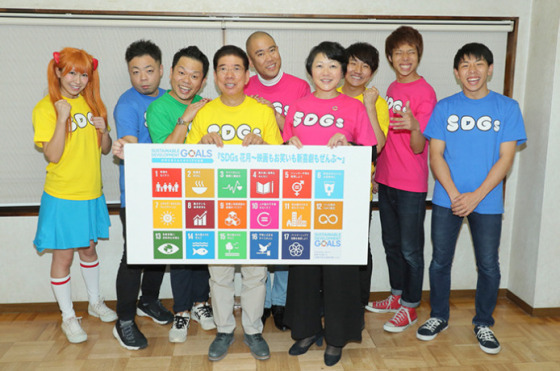KIFF Daily Report Day 2, Friday October 13, 2017
2017/10/13 Report

Belgian director Vanja d’Alcantara brought her Belgian-French-Japanese coproduction Kokoro to KIFF for a screening on Friday October 13 at Toho Cinemas Nijo. The audience was deeply moved by the story filmed mainly on the small island of Oki off the coast of Shimane prefecture in Japan.
The narrative revolves around Alice (Isabelle Carré), a woman living detached from her feelings in France. When her brother Nathan returns from Japan he tells her of how he has found life and love there. They have a nice reunion but eventually get in a fight from which he storms off. Tragically he’s then killed in a motorcycle accident, leaving Alice broken and lost. She decides to go to Japan to find out what Nathan discovered and it leads her to an isolated island with cliffs where people commit suicide. At that desolate place she meets Daisuke (Jun Kunimura), an ex-cop who saves people from death and gives them a temporary home. Slowly Alice can reconnect with her heart.
The writer-director noted the setting of the remote isle of Oki was key the piece. “After the screenplay was written and there was something there that was really mine it was a whole process to find the balance between the intimacy of the characters and the environment. That what I try to do in one film to another, to find a very deep emotion and go very close to the character, in a very special environment, in a very unique environment. And the environment has an influence on the characters.”
Renowned Japanese actor Jun Kunimura, who has worked with directors Ridley Scott and Quentin Tarantino, portrayed the character of Daisuke, the ex-cop spending every second of his time watching over cliffs known for suicides. Kunimura explained his attraction to the part. “The idea of a life and death in the film is interesting. The character of Daisuke doesn’t directly say “Don’t commit suicide” instead he gives the people some space to consider or live. He doesn’t tell them what to do. Daisuke first meets Alice’s brother and then comes to know Alice. He was usually dealing with Japanese but now he talks to a non-Japanese. Their culture, values or heritage may be different but they can share on a heart level.”
An animation symposium was held at Former Rissei Elementary School on KIFF’s second day. Japanese animation, known around the world simply as “anime,” was first screened exactly 100 years ago, in 1917. Over that time, the visual culture of Japan, especially to the international audience, has evolved.
KIFF is working with leaders in anime on a series of events, and Ichiya Nakamura, Chairman of the KIFF Executive Committee, opened this symposium.
Nakamura introduced the topic of Animation Tourism and the concept of connecting the trio of anime, tourism and traditional culture.
The hour-long symposium comprised of three special guests; Dai Kusaki of the Kyoto City Hall Tourism Bureau, Takayoshi Yamamura, Professor from Hokkaido University Center for Advanced Tourism Studies, and Nobuhiro Kikuchi, Executive Director at Progressive Animation Works.
“Anime tourism is a common phrase these days, referring to inbound tourism for people who want to discover famous locations they’ve seen in films, that we can call anime holy places or meccas,” said Yamamura. “This brings together three elements - anime, tourism and traditional culture.”
Kyoto has a spirit of tradition combined with modern elements, he explained, introducing Progressive Animation Works, a company based in Toyama that focuses on anime and local communities. He also divided Anime Tourism and its site-specific allure, and Content Tourism, a more general concept that brings tourists to experience pop culture in Japan.
The evening event SDGs Kagetsu, held at Yoshimoto’s Gion Kagetsu, saw an intriguing and hilarious collaboration between professional comedians and the Global Sustainable Development Goals of the United Nations.
It was in September 2015, that the United Nations General Assembly in New York adopted the SDGs, which include goals for all nations globally to improve the environment, create a better life for all citizens and develop “a world full of smiles.”
From five comedian groups, one comedian or group will be selected as the best comedy show based on the 17 SDGs of the United Nations.
Kaoru Nemoto, Director of the United Nations Japan, hails from Kobe and has been influenced by Manzai and Yoshimoto comedians since she was young. It was her that first suggested a collaboration with Yoshimoto since the SDGs were announced by the United Nations two years ago.
“We hope to spread the message through laughter, because only announcing things from the UN it is hard to spread the message. Comedy we feel can be a way to reach the audience better,” said Nemoto.
The five comedians took to the stage wearing a rainbow of colored t-shirts emblazoned with a “SDG”s logo.
Each group had to choose 3 of the 17 goals in to their routine, with Nemoto serving as the judge to select the winner. Kiyoshi Nishikawa was on hand too, to cheer on the five groups. “I am working at Yoshimoto for 53 years and for me, the number 17, the goal of partnerships and supporting each other is the key,” he said.
Last up were Non-Style, who managed to incorporate as many of the goals as possible in to their routine, managing 11 goals as they portrayed a baseball player and his girlfriend as the player plans to give her a birthday present.
Nemoto decided to award Non-Style the prize of United Nations goods, including a baseball cap and back-pack. “They did well to try to get in as many as possible, and are great leader’s as experienced comedians.”
Non-Style revealed that much of the routine was actually improvised, but the comedy wasn’t over, as all comedians returned to the stage and entertained the audience.

- Facebook Share
- Twitter Share





